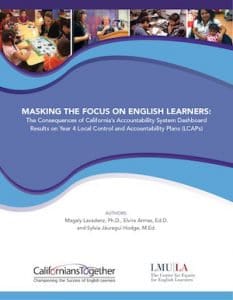Study of local plans identifies key improvements to fix the system

The report’s strongest recommendation is that the state discontinue aggregating the two subgroups and instead report them separately for analysis and planning.
“There is great potential for California school districts to be misled by the results of the combined EL subgroup. The decision to combine this data from two student groups with distinct language and academic profiles masks and impedes addressing their distinct academic needs,” said researcher and co-author, Dr. Magaly Lavadenz.
The report also claims that the system fails to accurately identify research-based programs, actions and services for English Learners.
Key findings presented in the report include:
- Despite all 24 districts being rated at the two lowest levels for English Learner performance, only six mentioned a concern for achievement in English Language Arts and only one specified a concern for their overall achievement.
- Minimal attention was paid to analysis of English Learner outcomes
- Course access and targeted services were inconsistently provided to current English Learners
- Minimal specific professional development was offered to teachers of English Learners.
“Obscuring current English Learner results has detrimental effects on districts’ abilities to address goals in local plans, set growth targets, focus program and services and allocate funds for this group of students. We call on the State Board of Education to rectify this measurement policy in order to ensure every English Learner can best be served,” said Shelly Spiegel-Coleman, executive director of Californians Together.
The study was conducted in collaboration with the Center for Equity for English Learners at Loyola Marymount University and reviewed local plans for 24 school districts that serve 23% of California’s English Learners.
The full report is available at www.californianstogether.org






